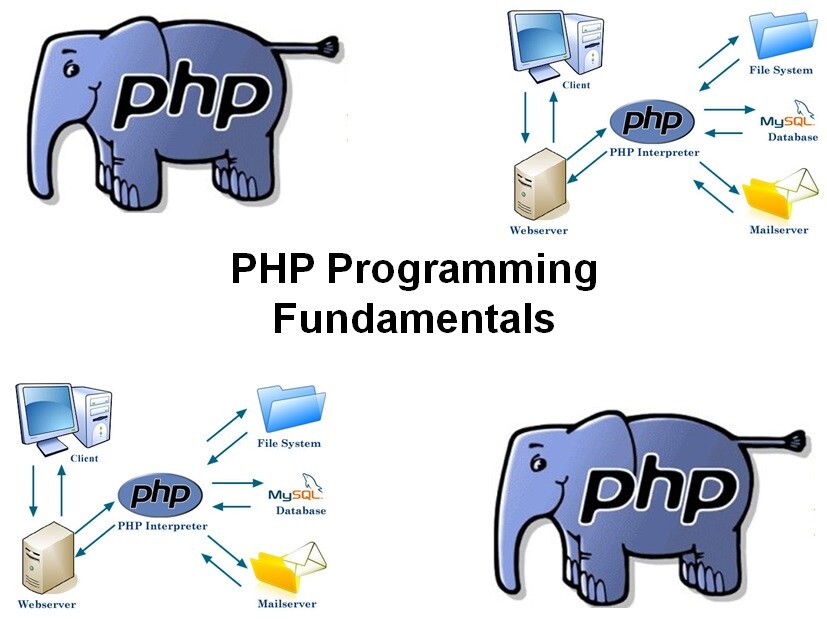-
Learning by doing
-
Trainers with practical experience
-
Classroom training
-
Detailed course material
-
Clear content description
-
Tailormade content possible
-
Training that proceeds
-
Small groups
The course PHP Programming covers the basic principles of the HTML-embedded scripting language PHP. PHP stands for Personal Hypertext Preprocessor, is available on Windows and Linux and is intended for developing dynamic Web pages.
The course discusses PHP version 7 and also the differences between PHP 5 and PHP 7 are discussed. PHP borrows much of its syntax from C, Java and Perl and also has an extensive library of functions. During the course participants work on a case study which consists of a number of follow-up exercises.
Participants learn to program with variables, data types, operators and control flow constructs of the PHP language. PHP functions and arrays are also addressed.
Central element of the course is the way to generate dynamic Web pages with PHP. Attention is also paid to submitting Web Forms, reading input parameters, handling errors, handling cookies and working with sessions.
Finally it is discussed how PHP can be used for accessing MySQL databases and files on the server.
An optional module, if time permits, is the validation of input forms using PHP. In conjunction with the course Advanced PHP Programming this course covers the requirements for the Zend PHP Certification exam.
The course PHP Programming is intended for Web developers who want to learn how to use PHP (PHP Hypertext Preprocessor) for writing dynamic Web pages.
To participate in this course HTML knowledge is required. Programming knowledge is beneficial for a rapid understanding.
The concepts are discussed on the basis of presentation slides and demos. The theory is interspersed with exercises. The course is done with PHP 7 which is installed in a WAMP package with the Apache Web server and MySQL.
Participants receive an official certificate PHP Programming after successful completion of the course.

Module 1 : PHP Introduction |
Module 2 : Variables and Operators |
Module 3 : Control Flow |
| What is PHP? PHP Usage Statistics Performance Comparison PHP Benefits PHP Processing Model The Script Tags PHP Basics PHP Output Statements PHP Installation PHP Configuration PHP IDE's |
PHP Constants PHP Variables PHP Data Types Weak and Dynamic Typing Number Data Type String Data Types Boolean Data Types PHP Operators Variable Interpolation Indexed Arrays Associative Arrays |
if Statement else Statement elseif Statement switch Statement for Loop while Loop do while Loop break Statement continue Statement Nested Loops foreach Loops |
Module 4 : Functions |
Module 5 : Submitting Forms |
Module 6 : Error Handling |
| User Defined Functions Variable Scope Static Variables Case Sensitivity References Call by Reference Call by Value Terminating scripts Number Formatting PHP Library Functions Numerical Functions String Functions Array Functions |
HTTP Requests and Responses HTML Forms Form Submission Using POST and GET PHP Form Processing Using isset Submit on Self HTML Input Types Accessing Form Parameters Multiple Valued Form Elements HTTP Request Headers HTTP Status Codes PHP Superglobals |
Debugging Syntax Errors Logic Errors Displaying Errors Error Severity Levels Error Configuration Settings Error Reporting Logging Errors User Input Syntactical Errors Semantical Errors Fatal Errors Non Fatal Errors Error Handling |
Module 7 : Cookies and Sessions |
Module 8 : File I/O |
Module 9 : Database Access |
| What are Cookies? Problems with Cookies Getting Cookies Setting Cookies Deleting Cookies Cookie parameters Setting Cookie parameters Why Session Tracking? Session ID's Session Tracking Session Tracking Mechanisms PHP Sessions |
PHP Files Overview Creating and Opening Files Reading Files Writing Files Deleting Files Navigate within a File fgets Function file_get_contents Function file_put_contents Function Uploading Files Handling Uploaded Files Uploaded File Location |
PHP and Data Access What is mysqli? Connecting to MySQL mysqli Connection Functions mysqli Query Functions Data Definition Query Inserting Records Retrieving Results Fetch Functions Buffered Queries Unbuffered Queries Prepared Statements |
Optional Module : Validation |
||
| Hidden Field to Enable Validation Validating Form Data Displaying Error Messages Required Fields Integer Fields Checking an Integer Range Floating Point Fields Checking an Email Address Default Values Checking Login Data |
